The Impressions Atlantic City Expo took place from March 23 to 25 in Atlantic City, NJ and gave our Decorator and Digital Solutions Team an opportunity to see what equipment and production supply companies decided to prioritize heading into spring.
- Screen room automation continues to grow in interest and possibilities as computer-to-screen and auto-reclaim equipment dotted the show floor.
- Fulfillment automation also drew a large sense of interest as various companies highlighted their folding, packaging and tagging systems.
- Industry stalwarts brought their legacy assortment of products to display, forgoing new stories and highlighting proven winners.
- Younger supply companies tweaked existing best sellers to optimize performance.
Perhaps most important of all, the Atlantic City Convention Center floor saw its biggest attendee turnout since 2019, a great sign that tradeshow trepidation appears to be fading. Here’s what our team found out while we were there.
Supacolor Introduces Supanew Next Gen Heat Transfer
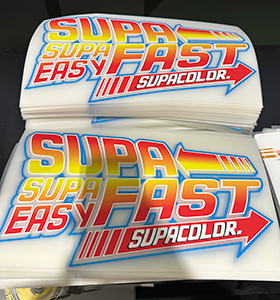 One of Supacolor’s core company philosophies is making things “supaeasy” for their customer. Case in point, their website simulates an experience similar to visiting a high-end food truck. While some production supply companies have robust menus of products to get lost amongst, Supacolor simplifies your purchasing options by offering a select handful of digital heat transfer styles that all perform exceptionally well for their intended purpose.
One of Supacolor’s core company philosophies is making things “supaeasy” for their customer. Case in point, their website simulates an experience similar to visiting a high-end food truck. While some production supply companies have robust menus of products to get lost amongst, Supacolor simplifies your purchasing options by offering a select handful of digital heat transfer styles that all perform exceptionally well for their intended purpose.
Their Blocker product is intended to be pressed onto patterned/dye sublimated technical fabrics that are universally challenging to decorate. Supacolor combines a high opacity white water-based ink along with their special bleed resistant blocking formula and packages it into a low temp transfer perfect for resisting dye migration.
Meanwhile, their Soft Shell Blocker accomplishes the same task, only they’ve tweaked the blocking technology to accompany application on soft shell and water-repellent outerwear styles.
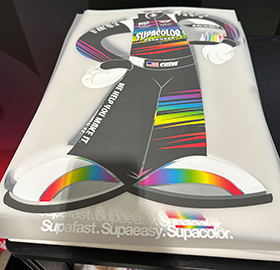 This technology is not new and is one of Supacolor’s strongest calling cards. What is new is an adjustment to their recipe to give the decorator a longer window to peel the carrier.
This technology is not new and is one of Supacolor’s strongest calling cards. What is new is an adjustment to their recipe to give the decorator a longer window to peel the carrier.
Supacolor has always been a hot peel transfer, but the window to peel the transfer successfully was very short. At times, if the decorator didn’t peel almost immediately, they might have had issues with the transfer lifting away with the carrier. With the new version of Supacolor, they have extended the peel window to give the decorator more time to peel the carrier without experiencing these problems. This allows the decorator to peel more confidently without the added stress of immediately removing the carrier post-production.
This next generation of Supacolor has also received a vibrant color upgrade that enhances those colors and really makes them pop.
Supacolor has always had a winning digital transfer formula. Now, with their new focus on improving the user experience, this winning formula has been coupled with a low-maintenance process to amplify results.
Hooptech Displays its Lineup of Legacy Products
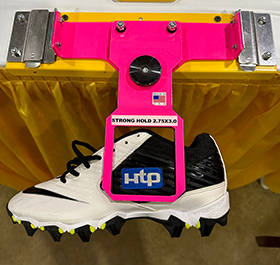 In the world of embroidery clamps and frames, few companies stand as tall as Hooptech Products. In Atlantic City Hooptech had a bevy of their greatest hits on display, such as their Gen 2 Cap Frame, Slimline Clamping System, and Glove and Shoe Clamps.
In the world of embroidery clamps and frames, few companies stand as tall as Hooptech Products. In Atlantic City Hooptech had a bevy of their greatest hits on display, such as their Gen 2 Cap Frame, Slimline Clamping System, and Glove and Shoe Clamps.
While embroidery on headwear can often be the bane of the decorator’s day, Hooptech’s Gen 2 Cap Frame changes the game by maximizing available embroidery space with taut, even sewing fields, so you can sew very close to the bill with less flagging and fewer needle breaks. The system greatly improves your process with hooping hats for more consistency, and less waste. Everything from unstructured to structured caps, visors, and even some bucket cap styles, this cap frame will fill many hat hooping needs. Even better the cap frame will click right onto your existing cap driver and can be used alongside the compact back of Caps Frame. Please note, you will need a T-Bar Framing Gage to successfully use the Gen 2 Cap Frame.
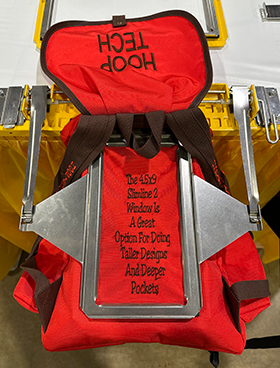 Hooptech’s Slimline Clamping Systems are low-profile and attach directly to the rail of the embroidery machine; best of all, they’re extremely versatile in their ability to handle any thickness of material.
Hooptech’s Slimline Clamping Systems are low-profile and attach directly to the rail of the embroidery machine; best of all, they’re extremely versatile in their ability to handle any thickness of material.
The Slimline features multiple products, including the Slimline 1 Clamping System which features seven interchangeable window sizes to suit your sewing needs. These window sizes range in size from 2.5” round to a 6.5”x5.5” window. Several benefits of this system include the ability for the clamp to fit over zippers, automatic adjustment to thickness, and avoiding hoopburn. This clamping system is best for single-head use and is ideal for smaller bags, such as lunch bags and coolers, knit caps and more.
The Slimline 2 Clamping System also features seven interchangeable window sizes but ranges from an 8”x5” to a 12”x9” window, and is ideal for use on towels, blankets, large bag panels, jacket backs and more.
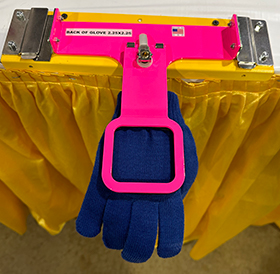 Lastly, Hooptech also had several Specialty Clamps on display, such as their Glove and Shoe Clamp. Their Glove Clamp offers a square window that allows the embellisher to embroider a tighter area, even accommodating a small pocket. It has a low-profile handle that swivels to easily open and close the clamp and has a slit that holds the backing in place. Hooptech’s Shoe Clamps were made specifically for embroidery on the tongue and side of shoes. These heavy-duty clamps have a knob that allows you to tightly secure the shoe into the frame. You can then embroider on slip-ons, sneakers, tongues, cleats and other various types of footwear.
Lastly, Hooptech also had several Specialty Clamps on display, such as their Glove and Shoe Clamp. Their Glove Clamp offers a square window that allows the embellisher to embroider a tighter area, even accommodating a small pocket. It has a low-profile handle that swivels to easily open and close the clamp and has a slit that holds the backing in place. Hooptech’s Shoe Clamps were made specifically for embroidery on the tongue and side of shoes. These heavy-duty clamps have a knob that allows you to tightly secure the shoe into the frame. You can then embroider on slip-ons, sneakers, tongues, cleats and other various types of footwear.
While Hooptech didn’t have any new technology to showcase at this expo, they had a very robust lineup of seven years’ worth of proven, high-quality products.
ROQ Fold Establishes a Starting Point for Automated Packaging
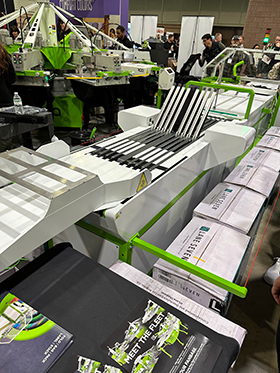 Automated folding is not new to the industry, but you wouldn’t think that to be the case at the ROQ International booth with the number of patrons surrounding the ROQ Fold on the show floor in Atlantic City. Driven by the philosophy that manual fulfillment is slow, labor-intensive and costly, the ROQ Fold automates your fulfillment and can drastically improve productivity, efficiency and overall ROI.
Automated folding is not new to the industry, but you wouldn’t think that to be the case at the ROQ International booth with the number of patrons surrounding the ROQ Fold on the show floor in Atlantic City. Driven by the philosophy that manual fulfillment is slow, labor-intensive and costly, the ROQ Fold automates your fulfillment and can drastically improve productivity, efficiency and overall ROI.
The ROQ Fold aims to fold any type and/or shape of garment including t-shirts, sweatshirts, polos, bottoms, etc. via the machine’s servo-driven guides. These servo drives take the command signal for position and speed requirements based on the garment and adjusts the applied servo motor using closed loop control.
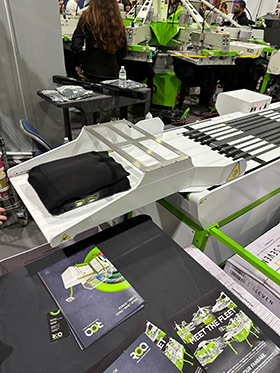 The unit features a custom recipe setup so you can fold the garment to your exact liking. These custom recipes accommodate for sleeves, body, and the final fold. The Fold also has two configurations, with or without the sleeve folding option, so the machine can potentially occupy less space within your shop if folding sleeves is not a priority. If folding sleeves is a requirement, then ROQ has made a handy adjustment slider for sleeve width to accommodate different categories and lengths of garments.
The unit features a custom recipe setup so you can fold the garment to your exact liking. These custom recipes accommodate for sleeves, body, and the final fold. The Fold also has two configurations, with or without the sleeve folding option, so the machine can potentially occupy less space within your shop if folding sleeves is not a priority. If folding sleeves is a requirement, then ROQ has made a handy adjustment slider for sleeve width to accommodate different categories and lengths of garments.
Perhaps best of all, only one operator is required to run the loading station at the head of the machine, and ROQ claims that the unit can process up to a maximum of 700 pieces per hour. This would make the ROQ Fold one of the fastest machines on the market today. If speed is not a priority, the unit can be set to automatic with three different speeds to choose from and can also be operated by foot pedal.
For completionists, this unit can be paired with several combinations of the ROQ Bag, ROQ Stack, ROQ Pack and ROQ Label models to provide a fully automated solution for the finishing services department of any shop.
Riso’s Goccopro Offers an Easy and Affordable Alternative to Screen-Making
In one of our previous articles we discussed the topic of Automating Your Screen Room. Japan-based company Riso has introduced a concept to that process via their Goccopro lineup of devices that offers a thermal imaging technology and eliminates the use of film positives, emulsion, dark rooms, and even water.
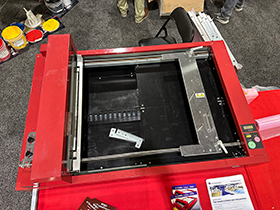 The Goccopro is a dry, tabletop screen-making process with thermal screen technology. This computer-to-screen technology introduces a thermal head that heat-perforates a screen of mesh laminated with film. This enables a low-cost, speedy screen-making process that eliminates waste from water and solvents, as well as electricity consumption.
The Goccopro is a dry, tabletop screen-making process with thermal screen technology. This computer-to-screen technology introduces a thermal head that heat-perforates a screen of mesh laminated with film. This enables a low-cost, speedy screen-making process that eliminates waste from water and solvents, as well as electricity consumption.
The unit is exceptionally easy to operate, supports multiple frame sizes (the QS2536 supports A2 size images, while the QS1836 is suitable for A3 size images), and can be used for multi-color work. It’s important to note that the film laminated mesh is most ideal for low-to-medium production printing, or roughly 200 to 800 prints. If the print run is longer, the user may experience a breakdown in the film. This is a single-use mesh and will need to be discarded following production. While the mesh size options are somewhat limited, it does run the gamut across low mesh count to high mesh count options.
This piece of equipment is most ideal for startup shops looking to enter the screen printing landscape by eliminating the amount of purchases needing to be made to establish a fully functional screen room. It’s also an ideal investment for established shops that have a consistent low-to-medium print run demand.
For a specific type of screen printer, this computer-to-screen technology can hit a sweet spot that eliminates many of the waste and hassle factors that a traditional screen room demands.
Until Next Time!
We hope to see you at your nearest decorator show sometime this year. Feel free to consult our Decorator and Digital Solution Team’s page for a complete list of our Team’s 2023 show itinerary.
